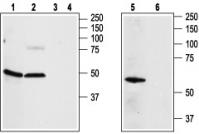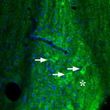Adora2a Rabbit Polyclonal Antibody
Other products for "Adora2a"
Specifications
| Product Data | |
| Applications | IHC, WB |
| Recommended Dilution | WB: 1:200-1:2000; IHC: 1:100-1:3000 |
| Reactivities | Human, Mouse, Rat |
| Host | Rabbit |
| Clonality | Polyclonal |
| Immunogen | Peptide (C)RQLKQMESQPLPGER, corresponding to amino acid residues 201-215 of mouse A2A Adenosine receptor. 3rd intracellular loop. |
| Formulation | Lyophilized. Concentration before lyophilization ~0.8mg/ml (lot dependent, please refer to CoA along with shipment for actual concentration). Buffer before lyophilization: Phosphate buffered saline (PBS), pH 7.4, 1% BSA, 0.05% NaN3. |
| Purification | Affinity purified on immobilized antigen. |
| Conjugation | Unconjugated |
| Storage | Store at -20°C as received. |
| Stability | Stable for 12 months from date of receipt. |
| Gene Name | adenosine A2a receptor |
| Database Link | |
| Background | Adenosine is an endogenous nucleoside generated locally in tissues under conditions of hypoxia, ischemia, or inflammation. It modulates a variety of physiological functions of many tissues including brain and heart. Adenosine exerts its action via four specific adenosine receptors (also named P1 purinergic receptors): A1-Adenosine Receptor (A1AR), A2A-Adenosine Receptor (A2AAR), A2B-Adenosine Receptor (A2BAR), and A3-Adenosine Receptor (A3AR). All are integral membrane proteins and are members of the G protein-coupled receptor superfamily, which share a common structure of seven putative transmembrane domains, an extracellular NH2 terminus, cytoplasmic COOH terminus, and a third intracellular loop important for binding G proteins. The adenosine receptors can be distinguished on the basis of their differential selectivity for adenosine analogs. Adenosine receptors control neurotransmitter release through the facilitatory A2AAR and the inhibitory A1AR. A2AAR and A1AR are the major adenosine receptor subtypes expressed in the central nervous system (CNS). A2AAR is mainly expressed in the striatum on GABAergic striatopallidal neurons, while A1AR is widely distributed throughout the CNS. A2AAR was suggested to play a critical role in attenuation of systemic inflammatory responses and prevention of extensive tissue damage. It was suggested that extracellular adenosine that accumulates in inflamed and damaged tissue may activate the A2AAR expressed in immune cells leading to termination/inhibition of the immune response. It was further suggested that this same mechanism may protect tumors from antitumor T cells through an immunosuppressive signal generated by the activation of A2AAR on T cells by extracellular adenosine produced from hypoxic cancerous tissues. |
| Synonyms | ADORA2; hA2aR; RDC8 |
| Reference Data | |
Documents
| Product Manuals |
| FAQs |
{0} Product Review(s)
0 Product Review(s)
Submit review
Be the first one to submit a review
Product Citations
*Delivery time may vary from web posted schedule. Occasional delays may occur due to unforeseen
complexities in the preparation of your product. International customers may expect an additional 1-2 weeks
in shipping.






























































































































































































































































 Germany
Germany
 Japan
Japan
 United Kingdom
United Kingdom
 China
China





